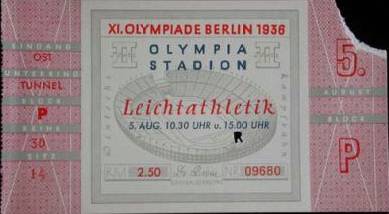Tickets
At the 1932 Olympic Games, it was possible
to adopt the system customary in the U.S.A. of one price category, or at
the most two. In Berlin, however, it was necessary to take into consideration
the entirely different financial circumstances and habits of European lovers
of sport. This led us to base our division into categories on the system
followed in Amsterdam, where, moreover, season tickets for the different
sports had been sold. As contrasted with 324 different kinds of tickets
in Amsterdam, there were 166 in Los Angeles, and 660 in Berlin. 
The tickets were designed by the artist Werner Beucke and printed by the Giesecke & Devrient Press of Leipzig which specializes in the printing of securities. The firms, Bajanz & Studer, Berlin, and Bireka A. G., Staaken, provided tickets for the elimination rounds as well as tickets needed shortly before or during the Olympic Games (for example, for the repetition of the Festival Play). Three principles governed the production of the tickets: 1. The print, size and colour of the tickets:
as well as the order of the necessary particulars printed on the The tickets were divided into four principal
types. 
1. Tickets for the Olympic Stadium. They were distinguished from the tickets for all other centres where contests were held by their size: 5 X 2.8 inches. In the centre was a picture of the Olympic Stadium from an original woodcut. The six colours for 1st and 2nd stand seats, 3rd stand seats on the east side and on the west side, standing room on the east side and standing room on the west side, were different for the first and second weeks. On the back of the ticket was a plan of the Olympic Stadium. 2. Tickets for other centres of competition. They were 5.2 X 2.4 inches. In the centre
was the Olympic Bell. It was also impossible in this case to have different
colours for each category. Therefore a different colour was merely used
for each site. On the back of the tickets was a plan showing the location
of the different sites. 
3. Tickets placed on sale after July 1st, 1936. The danger of forgery was not great in the case of these tickets. They were therefore given a simpler form. They were principally tickets for the art exhibition, for the handball and football elimination rounds, half-day and similar tickets. In order to be prepared for unforeseen eventualities, 100,000 general tickets without dates or mention of location were printed in nine categories. It was necessary to use these tickets in several instances. 4. Blanket Passes. These were special tickets of two types. One was of the same size as the Olympic Stadium tickets and valid only for this site. The other one, which was 5.2 X 2.4 inches, with no place indication, was valid for all events and performances. These passes were for visitors who could prove that their tickets had been lost. In special cases they were also used to fulfil urgent requirements for complimentary tickets, to permit the entry of groups in mass formation and for other special arrangements. (Source document: Official Report 1936, Vol. I, page 481) |

|

|
|

|

|
|
Numbers of visitors: 3.769.900